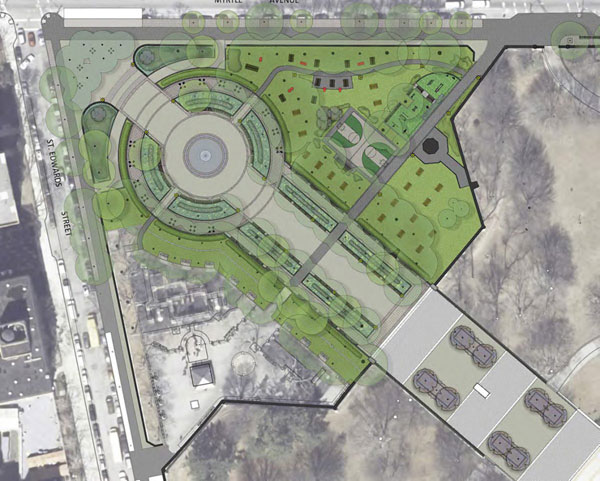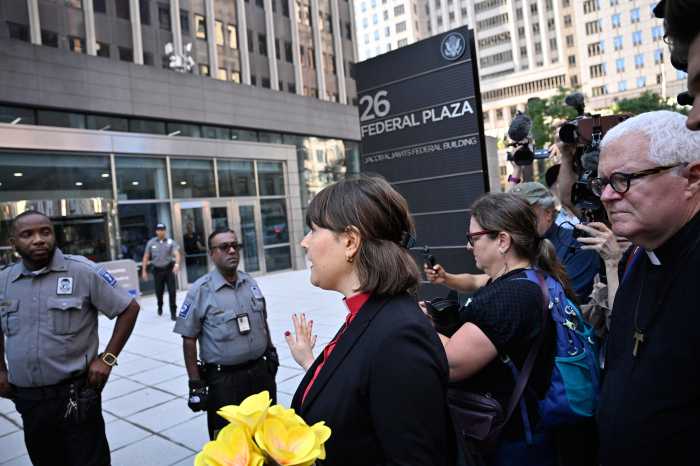It’s tree-son!
City officials fibbed to advance their controversial redesign for a section of Fort Greene Park when they claimed that dozens of meadow trees destined for the hatchet are sick and near-death, because most of the green things are actually young and in prime health, according to some locals who cited a report from city-hired arborists.
“It indicates that, contrary to what our people were told along the way, poor health of trees was a very minor issue,” said Michael Gruen, an attorney representing Friends of Fort Greene Park, a group that opposes the makeover.The Landmarks Preservation Commission green-lit the polarizing changes last month following the project’s September approval by Community Board 2, which cleared the way for the Department of Parks and Recreation to break ground on it in 2019.
The agency, as part of its “Parks Without Borders Program,” plans to make Fort Greene Park’s entry at Myrtle Avenue and St. Edwards Street more welcoming to pedestrians by turning it into a grand corner entrance that leads to the Prison Ship Martyrs Monument, which requires leveling some hilly mounds, creating a paved walkway to the memorial, and chopping down trees.
Parks department honchos told locals during the several-month planning process that the green things chosen for removal wouldn’t survive for much longer. But the agency’s forestry report — a survey of all 129 trees currently growing where the redesign would occur that Friends of Fort Greene Park received via a Freedom of Information Act request and shared with this newspaper — shows that many of the trees deemed old and ill were anything but, according to Gruen.
“They were told that approximately 50 trees were sick or bad in age, would die within a few years, and had to be removed,” the lawyer said. “Removing these trees had nothing to do with their health or age.”
Officials plan to axe 49 of the 129 trees in that corner of the park, 26 of which are large Norway maples — green things classified as invasive by the city, which added the species to its “do not plant list” in 2006 — according to information from the report and parks department.
Foresters initially pegged the maples as young and healthy after a visual assessment of their condition and size, according to a parks department spokeswoman, who said the agency later learned the trees were likely added in the early 1970s when they were between five and 10-years-old and claimed they are “certainly not young trees.”
But a 10-year-old Norway maple planted in 1970 would be 57, which is only one third of the species’ total lifespan, according to information from a State University of New York college.
The agency will also cut down around 23 non-maple trees in the area — including some London planes, honey locusts, and zelkovas — only nine of which are sick, according to the forestry report. The rest, including all nine honey locusts currently standing at the corner being made over, are being felled to accommodate the new design, the document says.
Workers will replace most of the uprooted green things with saplings from the much smaller caliper species, which is about three-to-five inches in diameter as opposed to the Norway maple’s heftier 10-to-13 inch girth, the parks-department spokeswoman said.
Friends of Fort Greene Park members hired an independent arborist from Glaeser Horticultural Consulting to review the vitality of the to-be-felled trees, and that investigation showed the green things are young and in good health, though it did note that a handful of maple trees suffer from minor root problems that could be corrected without cutting them down.
Residents’ outcry over the trees getting the axe led some top city officials to question the plan, with one demanding the Landmarks Preservation Commission rescind its approval of the makeover until the city truly reviews the environmental impacts of removing the green things and other aspects of the redesign, including leveling the grassy mounds and covering absorbent grass with a paved walkway.
“I believe that the city has not done its due process, and that the redesign dulls the environmentally resilient features that the park currently provides, such as mitigating storm water runoff,” Public Advocate Letitia James penned in a Nov. 27 letter to the commission. “The city has not done the proper environmental review.”
James fired off the letter hoping it would prompt the landmarks agency to reconsider its vote, according to a spokesperson. Her missive followed a similar request for a supplemental environmental study that Gruen made ahead of the commission’s vote, which the preservationists did not act on.
But the city does not need the landmarks agency’s approval to conduct a supplementary environmental review, according to a rep, who did not comment on whether the commission would consider rescinding its vote.





















